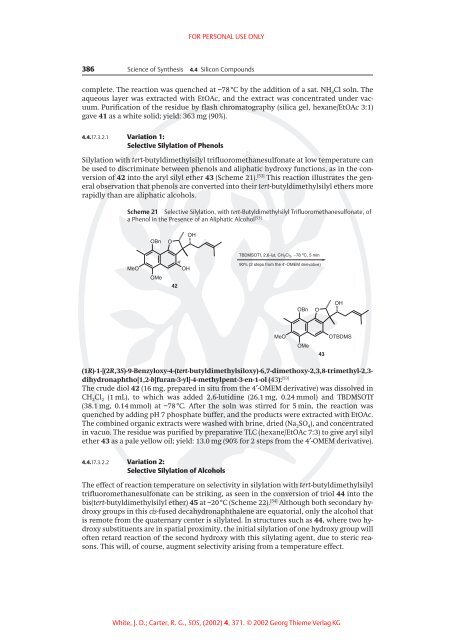Silyl Ethers - Thieme Chemistry
Silyl Ethers - Thieme Chemistry
Silyl Ethers - Thieme Chemistry
Create successful ePaper yourself
Turn your PDF publications into a flip-book with our unique Google optimized e-Paper software.
complete. The reaction was quenched at ±788C by the addition of a sat. NH 4Cl soln. The<br />
aqueous layer was extracted with EtOAc, and the extract was concentrated under vacuum.<br />
Purification of the residue by flash chromatography (silica gel, hexane/EtOAc 3:1)<br />
gave 41 as a white solid; yield: 363 mg (90%).<br />
4.4.17.3.2.1 Variation 1:<br />
Selective <strong>Silyl</strong>ation ofPhenols<br />
<strong>Silyl</strong>ation with tert-butyldimethylsilyl trifluoromethanesulfonate at low temperature can<br />
be used to discriminate between phenols and aliphatic hydroxy functions, as in the conversion<br />
of 42 into the aryl silyl ether 43 (Scheme 21). [53] This reaction illustrates the general<br />
observation that phenols are converted into their tert-butyldimethylsilyl ethers more<br />
rapidly than are aliphatic alcohols.<br />
Scheme 21 Selective <strong>Silyl</strong>ation, with tert-Butyldimethylsilyl Trifluoromethanesulfonate, of<br />
a Phenol in the Presence of an Aliphatic Alcohol [53]<br />
MeO<br />
OBn<br />
OMe<br />
O<br />
42<br />
4'<br />
OH<br />
FOR PERSONAL USE ONLY<br />
386 Science of Synthesis 4.4 Silicon Compounds<br />
OH<br />
TBDMSOTf, 2,6-lut, CH 2Cl2, −78 o C, 5 min<br />
90% (2 steps from the 4'-OMEM derivative)<br />
MeO<br />
OBn<br />
OMe<br />
O<br />
43<br />
OH<br />
OTBDMS<br />
(1R)-1-[(2R,3S)-9-Benzyloxy-4-(tert-butyldimethylsiloxy)-6,7-dimethoxy-2,3,8-trimethyl-2,3dihydronaphtho[1,2-b]furan-3-yl]-4-methylpent-3-en-1-ol<br />
(43): [53]<br />
The crude diol 42 (16 mg, prepared in situ from the 4¢-OMEM derivative) was dissolved in<br />
CH 2Cl 2 (1 mL), to which was added 2,6-lutidine (26.1 mg, 0.24 mmol) and TBDMSOTf<br />
(38.1 mg, 0.14 mmol) at ±788C. After the soln was stirred for 5 min, the reaction was<br />
quenched by adding pH 7 phosphate buffer, and the products were extracted with EtOAc.<br />
The combined organic extracts were washed with brine, dried (Na 2SO 4), and concentrated<br />
in vacuo. The residue was purified by preparative TLC (hexane/EtOAc 7:3) to give aryl silyl<br />
ether 43 as a pale yellow oil; yield: 13.0 mg (90% for 2 steps from the 4¢-OMEM derivative).<br />
4.4.17.3.2.2 Variation 2:<br />
Selective <strong>Silyl</strong>ation ofAlcohols<br />
The effect of reaction temperature on selectivity in silylation with tert-butyldimethylsilyl<br />
trifluoromethanesulfonate can be striking, as seen in the conversion of triol 44 into the<br />
bis(tert-butyldimethylsilyl ether) 45 at ±208C (Scheme 22). [54] Although both secondary hydroxy<br />
groups in this cis-fused decahydronaphthalene are equatorial, only the alcohol that<br />
is remote from the quaternary center is silylated. In structures such as 44, where two hydroxy<br />
substituents are in spatial proximity, the initial silylation of one hydroxy group will<br />
often retard reaction of the second hydroxy with this silylating agent, due to steric reasons.<br />
This will, of course, augment selectivity arising from a temperature effect.<br />
White, J. D.; Carter, R. G., SOS, (2002) 4, 371. 2002 Georg <strong>Thieme</strong> Verlag KG

















